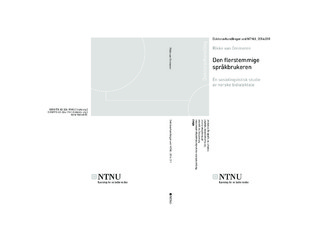| dc.contributor.advisor | Mæhlum, Brit | |
| dc.contributor.advisor | Hårstad, Stian | |
| dc.contributor.author | van Ommeren, Rikke | |
| dc.date.accessioned | 2017-01-27T10:07:08Z | |
| dc.date.available | 2017-01-27T10:07:08Z | |
| dc.date.issued | 2016 | |
| dc.identifier.isbn | 978-82-326-1961-0 | |
| dc.identifier.issn | 1503-8181 | |
| dc.identifier.uri | http://hdl.handle.net/11250/2428730 | |
| dc.description.abstract | Sammendrag av avhandlingen:
Kameleonen er en mye brukt metafor i omtale av bidialektale språkbrukere og hvordan de tilsynelatende etterligner de språklige omgivelsene sine for å gli inn eller skjule seg. Denne avhandlinga er en sosiolingvistisk studie av fenomenet bidialektisme, det vil si tilegnelse og bruk av det som forstås som mer enn én dialekt. Målet med studien har vært å beskrive og forstå dette fenomenet slik det framstår i en norsk kontekst.
Avhandlinga beskriver et utvalg norske bidialektales språkpraksiser, med vekt på vekslinga mellom det de og deres omgivelser forstår som ulike varieteter av norsk, og hvilke sosiokulturelle og (sosial-)psykologiske faktorer som former og påvirker disse individenes språklige praksiser. Et hovedfunn i studien er at norske bidialektale er mer enn mestere i forkledning; eksempler på kodeveksling illustrerer at bidialektale både kan og vil utnytte kodene sine aktivt og performativt for å skape retoriske effekter og konstruere identiteter i interaksjon. De er samtidig sosialiserte inn det norske språksamfunnet – et forestilt språklig praksisfellesskap – og både i ord og handling illustrerer de at de har blikk for hva de språklige praksisene deres kan tenkes å signalisere for andre medlemmer av dette fellesskapet. Derfor må norske bidialektales språkpraksiser forstås som uttrykk for kreativ utnyttelse av språklige ressurser innenfor rammene av de normene og ideologiene som til enhver tid legger føringer for språklig praksis i omgivelsene deres.
Studien er kvalitativt innrettet og overveiende utforskende, inspirert av Grounded theory. Det empiriske grunnlaget er opptak av intervju med 13 voksne individer og egenopptak av samtaler mellom fem av disse og sentrale personer i deres omgangskrets. Ut over dette er det også hentet inn data gjennom spørreskjema, uformell kommunikasjon og observasjon. | nb_NO |
| dc.description.abstract | Summary of the thesis:
The chameleon is often used as a metaphor in descriptions that involve bidialectal speakers and the way they seem to mimic their linguistic surroundings in order to blend in or hide. This thesis is a sociolinguistic study of bidialectalism, which is the acquisition and use of what is perceived as more than one dialect. The goal of the study has been to describe and understand this phenomenon within a Norwegian context.
The study describes the language practices of a group of Norwegian bidialectal speakers, with an emphasis on their practices of switching between what is perceived as different varieties of Norwegian, as well as the sociocultural and (social) psychological factors that shape and govern these individuals’ language practices. One of the main findings of the study is that Norwegian bidialectals are more than masters of disguise; examples of code switching illustrate that they have both the will and the skills needed to exploit their codes in an active and performative manner, in order to create rhetorical effects and construct identities in interaction. At the same time, they are socialized into the larger Norwegian language community – an imagined linguistic community of practice – and both what they do and what they say illustrates that they are aware of what their linguistic practices may signalize for others members of this community. On the basis of this, the thesis argues that Norwegian bidialectal speakers’ language practices must be understood as expressions of creative use of linguistic resources within the limitations that are posed by the norms and ideologies that shape and govern linguistic practices in their surroundings.
The study is qualitative and predominantly explorative, inspired by Grounded theory. The data on which it is based are made up of recordings of interviews with 13 adult individuals and recordings of conversations between five of these together with significant people in their social surroundings. In addition to this, some data have been collected through a written survey and informal communication and observations. | nb_NO |
| dc.language.iso | eng | nb_NO |
| dc.publisher | NTNU | nb_NO |
| dc.relation.ispartofseries | Doctoral theses at NTNU;2016:311 | |
| dc.title | Den flerstemmige språkbrukeren: En sosiolingvistisk studie av norske bidialektale | nb_NO |
| dc.type | Doctoral thesis | nb_NO |
| dc.subject.nsi | VDP::Humanities: 000::Linguistics: 010 | nb_NO |
